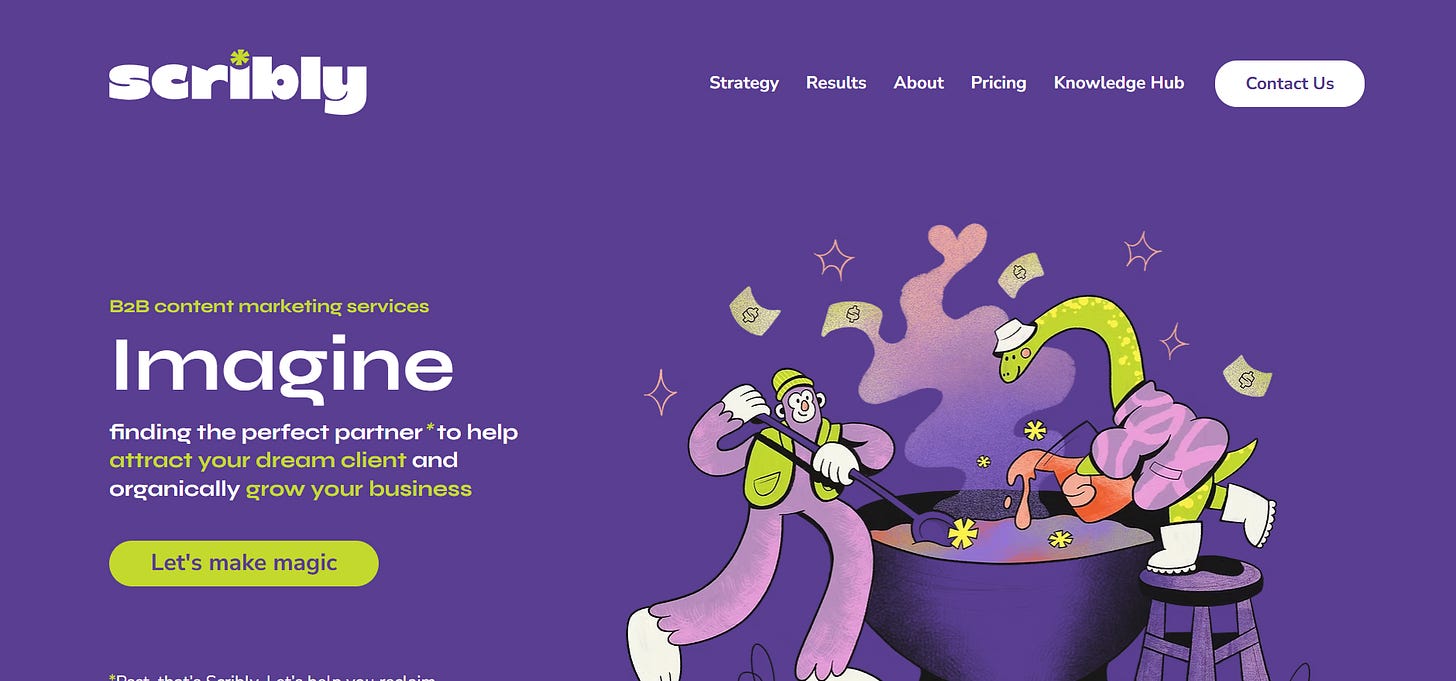What Happened When a Copywriter Said ‘No’ to Custom Work
The story of Scribly.io from chasing projects to building a productized service with 5 no-code tools.
From £20K Freelancer to £450K Business: The Scribly.io Story
How a copywriter cracked the code of productized services using 5 no-code tools
The Reality Check That Changed Everything
Dani Bell was stuck. After leaving the UK for Copenhagen with her husband, she'd been freelancing as a copywriter for months. The work was decent, but the money? Not so much.
She was charging per project, juggling multiple clients, and constantly hunting for the next gig. Sound familiar?
The problem wasn't her skills - clients loved her work. The problem was the business model. She was selling her time, and time doesn't scale.
One particularly busy week, she was managing five different clients with five different expectations, deadlines flying past, and her laptop practically smoking from overuse. That's when it hit her.
The Lightbulb Moment in a Coffee Shop
During a particularly stressful week in 2018, juggling five different clients with five different expectations, Dani had her revelation. She was sitting in a Copenhagen coffee shop, laptop overheating from too many browser tabs, when she noticed something odd.
Every single client was asking for the same thing: "Help us create content that actually brings in customers."
Small businesses were drowning in generic marketing advice. They knew they needed content marketing, but traditional agencies charged £5,000+ per month, and individual freelancers (like herself) couldn't deliver the consistency or scale they needed.
The gap was glaring businesses needed professional, results-driven content marketing that didn't require a corporate budget.
The 7-Day Validation Experiment
Instead of spending months building the perfect service, Dani did something counterintuitive. She announced her new "done-for-you content marketing service" to her existing freelance clients and a few founder communities on a Monday.
No fancy website. No detailed pricing pages.
Just a simple message: "I'm launching a monthly content service that handles your entire content strategy and production. Who's interested?"
By Sunday, she had £1,500 in commitments and three paying clients ready to start immediately.
The market had spoken. Loudly.
What Problem Was She Really Solving?
Scribly.io wasn't just another content agency. Dani had identified three pain points that traditional solutions missed:
The Overwhelm Problem: Small businesses knew they needed content but didn't know where to start or what to prioritize.
The Consistency Problem: Working with individual freelancers meant unpredictable quality and delivery schedules.
The Strategy Problem: Most content creators focused on writing, not on driving actual business results.
Dani's solution? A productized service that combined strategy, planning, and production into fixed monthly packages. Clients knew exactly what they'd get and exactly what they'd pay.
The Competition Landscape (And Why It Didn't Matter)
The content marketing space was crowded, but Dani had spotted something competitors missed. Large agencies focused on enterprise clients. Individual freelancers competed on price. Platform-based services offered cheap but generic content.
Nobody was serving growing businesses that needed professional content marketing at a predictable price point with actual strategic thinking behind it.
Instead of trying to compete with existing players, Dani created her own category: premium productized content marketing for businesses serious about growth.
The Customer Acquisition Playbook
Forget growth hacking tactics and viral loops. Dani's approach was refreshingly direct:
Existing Network First: She started with freelance clients who already trusted her work.
Community Presence: Active participation in entrepreneur communities where her ideal clients gathered.
Content Marketing: She practiced what she preached, creating valuable content that demonstrated her expertise.
Referral System: Happy clients became her best salespeople, leading to consistent word-of-mouth growth
The magic wasn't in the channels it was in the product-market fit. When you solve a real problem well, customers find you.
The Secret Sauce: What Made Clients Pay Premium Prices
Scribly.io commanded higher prices than freelancers and better results than agencies because of three unique elements:
Data-Driven Strategy: Every piece of content was anchored in keyword research and competitor analysis, not creative guesswork.
Predictable Delivery: Clients received consistent, professional content on schedule, every single month.
Business Results Focus: The content wasn't just well-written – it was designed to drive traffic, generate leads, and support sales goals.
Clients weren't paying for words on a page. They were paying for a system that reliably grew their business.
The 5-Tool Tech Stack That Changed Everything
Here's where the story gets interesting for no-code enthusiasts. Dani built a £450K business using just five tools:
Airtable: Client database, project tracking, and content calendar management
Webflow: Professional website without touching code
Google Docs: Content creation and client collaboration
Zapier: Automated workflows between all platforms
SPP (Strategic Planning Platform): Client strategy development and reporting
Total monthly cost: Under £200.
Total coding required: Zero lines.
This wasn't about the tools themselves it was about using technology to create systems that could operate without constant founder involvement.
Today's No-Code Opportunities: What You Can Build Right Now
The tools available today make Dani's 2018 stack look primitive. Here's what's possible now:
For Service Businesses:
Notion for client management and project workflows
Framer for stunning websites without developers
Make.com (formerly Integromat) for complex automation
Circle or Skool for client communities
Stripe for subscription billing
For Product Builders:
Bubble for full web applications
FlutterFlow for mobile apps
Supabase for databases
Vercel for hosting
OpenAI API for AI-powered features
The question isn't whether you can build your idea without code anymore. The question is: what problem will you solve?
Questions Every Founder Should Ask
Before diving into tools and tactics, consider these questions that guided Dani's success:
1. What expensive service can you turn into an affordable product?
2. Which part of your expertise can you systematize and scale?
3. What problem do people pay for but complain about the current solutions?
4. How can you validate demand before building anything complex?
5. What would your service look like if you removed all the unnecessary complexity?
The Numbers Game: From $0 to $37K MRR in 24 Months
Let's talk real numbers. Dani built Scribly.io to $30K MRR using no-code tools, but the journey wasn't a straight line up.
Month 1 (Launch): $2,000 in first week
Month 3: $5,000 MRR
Month 8: $10,000 MRR
Month 18: $25,000 MRR
Month 24: $37,000 MRR (which equals $444K ARR)
Around 9 months after launch, she was already hitting 5-figure MRR. But here's what most people miss - it wasn't smooth sailing.
The first few months were chaos. She'd land a big client, celebrate, then realize she had no systems to deliver consistently. She'd work 14-hour days trying to keep up, then lose clients because she couldn't scale her personal attention.
The real growth happened when she stopped trying to do everything herself and started building systems. That's when MRR started climbing steadily month over month.
What does $37K MRR actually mean?
Annual Recurring Revenue (ARR): $444,000
That's roughly 74 clients paying $500/month each
Or 37 clients paying $1,000/month
Generated with a team of just 4 people
The math is simple: MRR x 12 = ARR. But getting there? That took real work.
The Exit That Proved the Model
After 3 years building Scribly.io to $37K MRR, Dani made a decision that surprised everyone - she sold the business.
The exact sale price wasn't public, but here's what we know: profitable service businesses typically sell for 2-5x annual revenue. With $444K ARR, that puts the potential sale somewhere between $888K - $2.2M.
But the real validation wasn't the money. It was that the business kept running without her. New owners stepped in, and Scribly.io continued operating successfully. That's the hallmark of a real business it works without the founder.
Most "businesses" are just expensive jobs. Dani built something that could survive without her constant involvement.
What resonated most with you from Dani's journey? What problem in your expertise area could become your next productized service?
Share your thoughts, the next breakthrough might be simpler than you think.



